The OCZ Vector 180 (240GB, 480GB & 960GB) SSD Review
by Kristian Vättö on March 24, 2015 2:00 PM EST- Posted in
- Storage
- SSDs
- OCZ
- Barefoot 3
- Vector 180
AnandTech Storage Bench - The Destroyer
The Destroyer has been an essential part of our SSD test suite for nearly two years now. It was crafted to provide a benchmark for very IO intensive workloads, which is where you most often notice the difference between drives. It's not necessarily the most relevant test to an average user, but for anyone with a heavier IO workload The Destroyer should do a good job at characterizing performance.
| AnandTech Storage Bench - The Destroyer | ||||||||||||
| Workload | Description | Applications Used | ||||||||||
| Photo Sync/Editing | Import images, edit, export | Adobe Photoshop CS6, Adobe Lightroom 4, Dropbox | ||||||||||
| Gaming | Download/install games, play games | Steam, Deus Ex, Skyrim, Starcraft 2, BioShock Infinite | ||||||||||
| Virtualization | Run/manage VM, use general apps inside VM | VirtualBox | ||||||||||
| General Productivity | Browse the web, manage local email, copy files, encrypt/decrypt files, backup system, download content, virus/malware scan | Chrome, IE10, Outlook, Windows 8, AxCrypt, uTorrent, AdAware | ||||||||||
| Video Playback | Copy and watch movies | Windows 8 | ||||||||||
| Application Development | Compile projects, check out code, download code samples | Visual Studio 2012 | ||||||||||
The table above describes the workloads of The Destroyer in a bit more detail. Most of the workloads are run independently in the trace, but obviously there are various operations (such as backups) in the background.
| AnandTech Storage Bench - The Destroyer - Specs | ||||||||||||
| Reads | 38.83 million | |||||||||||
| Writes | 10.98 million | |||||||||||
| Total IO Operations | 49.8 million | |||||||||||
| Total GB Read | 1583.02 GB | |||||||||||
| Total GB Written | 875.62 GB | |||||||||||
| Average Queue Depth | ~5.5 | |||||||||||
| Focus | Worst case multitasking, IO consistency | |||||||||||
The name Destroyer comes from the sheer fact that the trace contains nearly 50 million IO operations. That's enough IO operations to effectively put the drive into steady-state and give an idea of the performance in worst case multitasking scenarios. About 67% of the IOs are sequential in nature with the rest ranging from pseudo-random to fully random.
| AnandTech Storage Bench - The Destroyer - IO Breakdown | |||||||||||
| IO Size | <4KB | 4KB | 8KB | 16KB | 32KB | 64KB | 128KB | ||||
| % of Total | 6.0% | 26.2% | 3.1% | 2.4% | 1.7% | 38.4% | 18.0% | ||||
I've included a breakdown of the IOs in the table above, which accounts for 95.8% of total IOs in the trace. The leftover IO sizes are relatively rare in between sizes that don't have a significant (>1%) share on their own. Over a half of the transfers are large IOs with one fourth being 4KB in size.
| AnandTech Storage Bench - The Destroyer - QD Breakdown | ||||||||||||
| Queue Depth | 1 | 2 | 3 | 4-5 | 6-10 | 11-20 | 21-32 | >32 | ||||
| % of Total | 50.0% | 21.9% | 4.1% | 5.7% | 8.8% | 6.0% | 2.1% | 1.4 | ||||
Despite the average queue depth of 5.5, a half of the IOs happen at queue depth of one and scenarios where the queue depths is higher than 10 are rather infrequent.
The two key metrics I'm reporting haven't changed and I'll continue to report both data rate and latency because the two have slightly different focuses. Data rate measures the speed of the data transfer, so it emphasizes large IOs that simply account for a much larger share when looking at the total amount of data. Latency, on the other hand, ignores the IO size, so all IOs are given the same weight in the calculation. Both metrics are useful, although in terms of system responsiveness I think the latency is more critical. As a result, I'm also reporting two new stats that provide us a very good insight to high latency IOs by reporting the share of >10ms and >100ms IOs as a percentage of the total.
I'm also reporting the total power consumed during the trace, which gives us good insight into the drive's power consumption under different workloads. It's better than average power consumption in the sense that it also takes performance into account because a faster completion time will result in less watt-hours consumed. Since the idle times of the trace have been truncated for faster playback, the number doesn't fully address the impact of idle power consumption, but nevertheless the metric is valuable when it comes active power consumption.
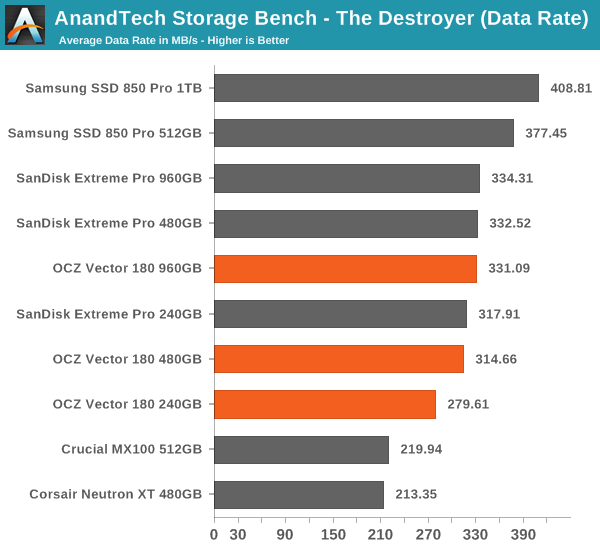
For a high-end drive, the Vector 180 has average data rate in our heaviest 'The Destroyer' trace. At 480GB and 960GB it's able to keep up with the Extreme Pro, but the 240GB model doesn't bear that well when compared to the competition.
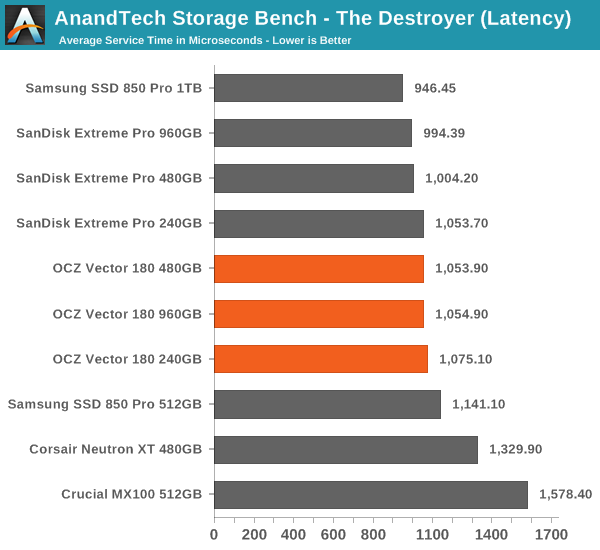
The same story continues when looking at average latency, although I have to say that the differences between drives are quite marginal. What's notable is how consistent the Vector 180 is regardless of the capacity.
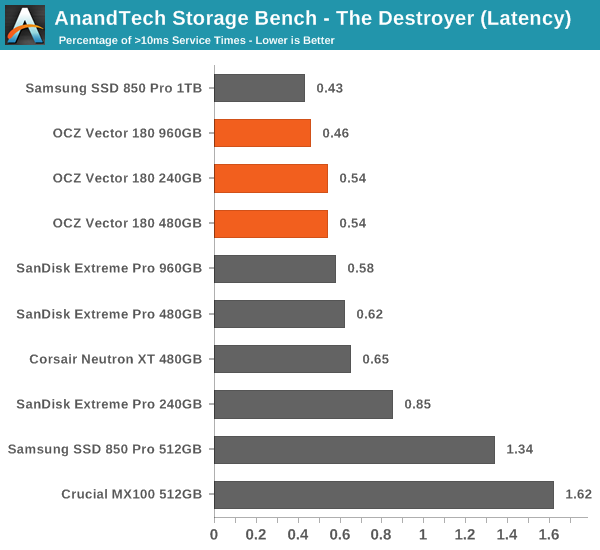
Positively, the Vector 180 has very few high latency IOs and actually leads the pack when looking at all capacities.
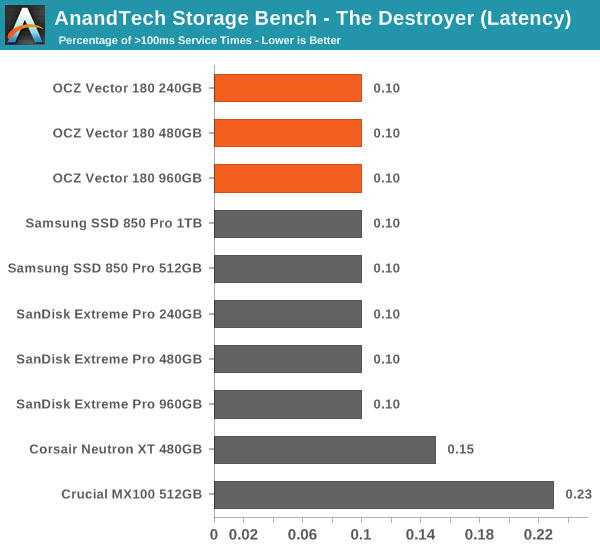
The Vector 180 also appears to be very power efficient under load and manages to beat every other SSD I've run through the test so far. Too bad there is no support for slumber power modes because the Barefoot 3 seems to excel otherwise when it comes to power.
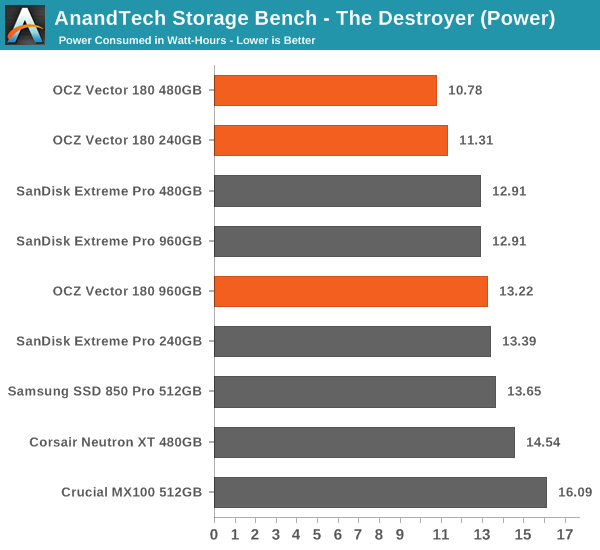










89 Comments
View All Comments
LB-ID - Thursday, March 26, 2015 - link
Looks like an overpriced product that doesn't stack up against competition in the same price range. Given OCZ's extensive track record of failures and attempts to use their user base as unpaid beta testers I can understand their desire to include a feature to give more peace of mind, but in reality it's just not that useful and certainly insufficient to overcome years of accumulated ill will.serndipity - Thursday, March 26, 2015 - link
The specifications say it all.On a $, performance, reliability, endurance, warranty basis, the OCZ 180 falls significantly short of even the consumer grade competition (e.g. Crucial or Samsung).
Unfortunately, the OCZ story when from deceiving investors, to customers, ending in bankruptcy.
Sadly, the same management etc., remains in place
Be smart and avoid OCZ
ocztosh - Monday, March 30, 2015 - link
Hi LB-ID, thank you for your feedback. We have shipped countless Barefoot 3 based drives across multiple series products and never once had to rev silicon. We have made updates to firmware to continually improve our products. The addition of the PFM+ feature was a decision to support customers that are really on the edge of enthusiast and workstation. This is a required feature for many enterprise drives and we felt there was a value to including this feature into our Vector 180 Series. We agree that not every customer necessarily needs this feature, and for those customers across the client spectrum we have other BF3 based drives that do not include the additional circuitry, but for those customers that really would like that extra layer of protection we were able to integrate this feature without a price premium over our previous Vector 150 Series. We have already received a very positive response from some users but will continue to offer a range of drives to meet the needs of different user applications.voicequal - Friday, March 27, 2015 - link
Wow, great review and a ton of new tests and data. The bathtub curve on the mixed sequential read/write performance will be very interesting to compare to forthcoming NVMe drives. I was surprised by how much the IOPS were reduced by commingling of sequential reads/writes. Seems to be room for improvement in this area.Ethos Evoss - Saturday, March 28, 2015 - link
The worst company of SSD's some OCZ or OWC or PVC .. jeez trash.. it's been sold to toshiba anyway ..ocztosh - Monday, March 30, 2015 - link
Hello Ethos Evoss. We are sorry that you feel this way and/or if you had a negative experience in the past. We are indeed now part of Toshiba and OCZ Storage Solutions is a very different organization as a subsidiary of Toshiba. Toshiba has provided the ability to vastly enhance resources for product development as well as given us complete access to their premium NAND. We certainly will continue to strive to meet the high expectations of you, our valued customers. Thank you again for your input.daerron - Tuesday, May 26, 2015 - link
Nice in depth analysis Anandtech! Read the article as I'm receiving a new Vector 180 240GB drive this week as my original Vector bricked itself earlier this month after around 2 years of service. I have to say that I'm really impressed with OCZ's customer service as I couriered the drive last week and will be receiving a brand new and latest SSD in return this week. Fortunately I had my data backed up as it really just died without any warning. Based on the analysis I was also thinking this would be a killer laptop drive, till I saw the lack of slumber support which is a bit of a disappointment and opportunity missed. Still the PFM+ and low power usage is also most welcome in my workstation PC. We have regular power cuts in my country so its great to have that extra peace of mind.bogdan_kr - Thursday, December 17, 2015 - link
Hello guys. I would like to ask how exactly this Storage Bench - Light is designed. The description says it is designed to be an accurate illustration of basic usage with Total IO Operations 832,339, Total GB Read 17.97 and Total GB Written 23.25.With its 23 GB of writes it should account for roughly two or three days of average usage (i.e. 7-11GB per day).
How long (typically) does it take to finish this bench?
Is it designed to last for few hours (which would account for a typical daily use) or is it designed to finish as fast as possible, in few minutes perhaps?
bogdan_kr - Saturday, January 23, 2016 - link
I am aware that most likely it is a rhetorical question but can anyone from AnandTech answer it, please? I just wanted to be sure about that benchmark.